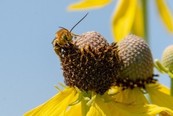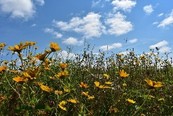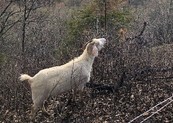Sprigs of scientific discoveries for natural resources managers
|
|
|
Volume 7 - November 2021
Ecological Restoration
More than ever before, ecological restoration is a booming industry in Minnesota. Restorations are not new to the state, but hundreds of millions of additional dollars have been invested in restoring and managing our landscape since Minnesotans approved the Clean Water, Land and Legacy Amendment in 2008. As natural resource managers, it is our responsibility to use the best available science to maximize the value of this investment for all Minnesotans. In this issue of the Reader, we offer some examples of recent research on ecological restoration, including building better prairies for bees and carbon sequestration, using goats to eat invasive species and rebuilding the lost savannas. These examples just scratch the surface of our ever-growing understanding of ecological restoration. To learn more about getting the most out of your restoration efforts, check out these additional restoration-related resources: The University of Minnesota Extension hosts webinars on improving restorations (more to come in the winter). The Legacy Fund Restoration Evaluation Program provides stories of success and recommendations for improving future projects. The USDA Forest Service has organized a wealth of resources on ecological restoration.
The Minnesota Research Reader is a collaboration between the Minnesota Department of Natural Resources and the U.S. Department of Agriculture Forest Service that provides a quick look at emerging research relevant to our work in the State of Minnesota. We hope you enjoy the selection of articles in this month's edition of the Reader!

Native bees are a frequent target of prairie restorations, due to bees’ dramatic decline and the critical pollination they provide native systems. More data are needed on whether native bee diversity is limited by the availability of pollen and nectar within a habitat or the quality of the surrounding landscape. Scientists with the University of Minnesota Native Bee Lab authored this 2020 article in Ecological Applications. The authors looked at the impact of forb diversity and increasing agricultural cover in the surrounding landscape of native bee populations. They found that, regardless of agricultural cover in the surrounding landscape, restored areas with more forb species attracted and supported more diverse bee communities.
Management Implications:
- If a desired outcome of restoration is high native bee diversity, practitioners should prioritize forb diversity.
- Bee communities may benefit from restoration of highly agricultural landscapes, especially in projects with high forb diversity.
|

This 2019 study, also authored by scientists at the University of Minnesota, looked at the effect of grassland restoration on carbon sequestration in soils. They compared carbon sequestration in naturally revegetated agricultural fields, restored fields planted as monocultures and restored fields planted with increasing levels of diversity. They found that, over time, restored grasslands sequestered up to 200% more carbon than fields left to revegetate naturally. The largest increases in carbon storage were seen in higher diversity plots, especially those with C4 warm season grasses and legumes.
Management Implications:
- Prairie and grassland restorations can have multiple benefits, including carbon sequestration; a mitigation strategy for climate change. Restoration goals should be identified in the planning phase to guide decision-making and maximize outcomes.
- Diverse seed mixes including both C4 grasses and legumes should be used in restorations that aim to maximize carbon sequestration.
|

Conservation grazing has long been used to maintain restorations and manage invasive species. Recently, natural resource managers and citizens are turning to goats to control common buckthorn (Rhamnus cathartica). In this study, researchers from the University of Minnesota tested the possibility that goats could spread buckthorn via ingestion and excretion of seeds in their feces. Three days after eating buckthorn berries, only 2% of the seeds were recovered intact. Of those that were intact, only about one out of ten were still viable. Because of this low survival rate, the researchers concluded grazing goats pose a very low risk for spreading buckthorn.
Management Implications:
- Goats can be an effective grazer for controlling populations of buckthorn in restorations.
- The risk of goats spreading buckthorn seeds is very low.
- Even with low risk of spread, managers should watch for buckthorn in new areas and eradicate plants before buckthorn can establish.
|

Whether you call them savannas, woodlands or open forests, these habitats have been lost in staggering numbers worldwide, and Minnesota is no exception. In this special issue of Forest Ecology and Management, scientists discuss emerging themes and challenges of restoring open forests. Because they contain both overstory trees and an herbaceous ground layer, open forests play an important role in biodiversity and present unique challenges to restore the structure and composition of the system. Ongoing management through fire and other disturbance tools is critical for maintaining the structure of restored open forests. This structure is necessary but not sufficient to restore the species composition and ecosystems processes that will maintain benefits of open forest restorations.
Management Implications:
- Restoring savannas in Minnesota often requires tree planting and protection as well as active restoration of an herbaceous understory.
- Maintaining healthy restored savannas will require long-term management including prescribed fire.
|
|
|
|
Photo credits from top to bottom: Minnesota Department of Natural Resources, Minnesota Department of Natural Resources, US Fish and Wildlife Service, Minnesota Department of Natural Resources
|
|
Please sign up for future editions and feel free to share with others!
Subscribe to the newsletter and visit our website for archived issues.
|
|